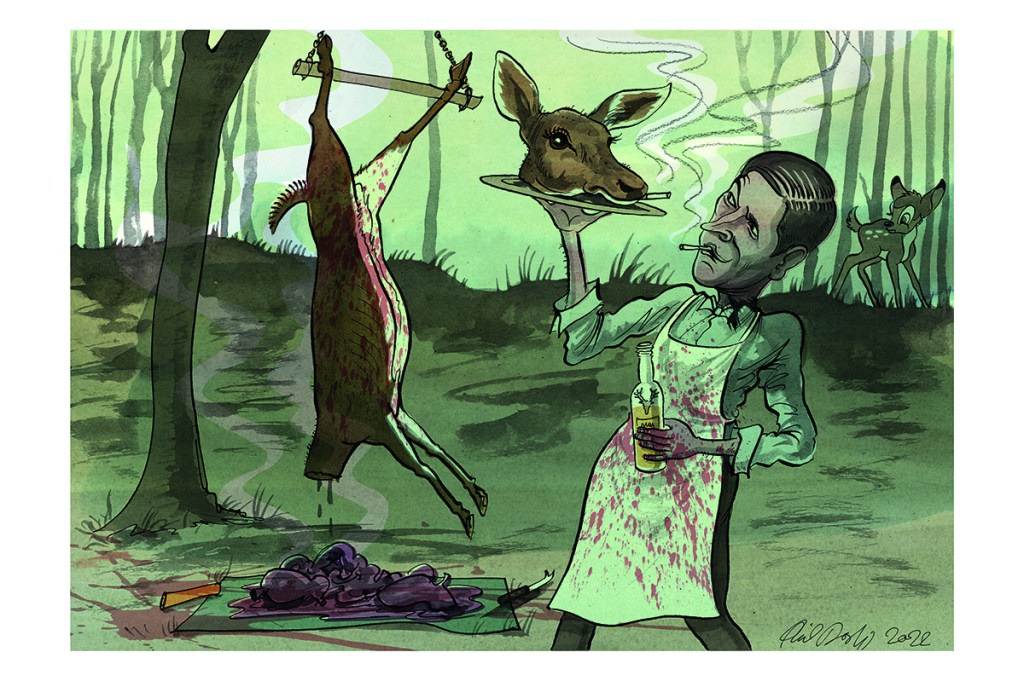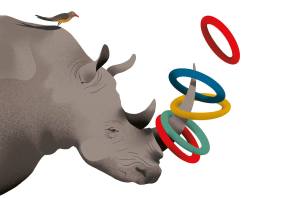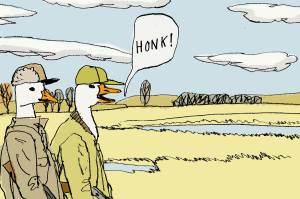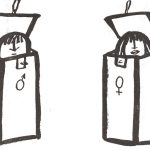I was driving along in my 2018 Honda minivan when I received a call from a member of the National Symphony Orchestra who has been on leave since March 2020: “Just bagged a doe. If you’re up for it, I’m going to gut this thing.”
I regretted taking the call through the van’s speakerphone. A text message followed; thankfully the image did not project onto the dash display. I spent the rest of the drive to school explaining to my four daughters how Daddy had to dissect Bambi for work.
My father took me hunting once in high school. He shook me awake at six in the morning, loaded me into the family car, a 1998 Chevy minivan, then drove it straight into a deer. I can still picture the white-spotted fawn’s body cascading across the asphalt. “Thank God it was just a baby.” We kept driving.
In Connecticut, our hatred of deer is pure as the riven doe. Deer are America’s deadliest animal; they kill about 200 of us annually. You are forty times more likely to die at the hooves of these majestic herbivores than you are from a bear attack. They are responsible for nearly 20 percent of the six million car accidents that occur in America each year. They have killed nearly as many of my friends as opioids, which is saying something.
Deer carry the ticks responsible for Lyme disease. Named for the Connecticut town where it was discovered in 1977, it afflicts more than 39,000 people each year, and some for many years after, if Ross Douthat is to be believed. One of the first conspiracy theories I heard growing up was that the disease was invented by the CIA. Was Bambi propaganda, designed to prevent us from culling the deer population, so deer can cull more of the human population? The people who entertain this theory speak about it the way Black Panthers talk about the crack epidemic. Still, it is a mystery why the WASPs over at the mid-century CIA and the eugenically minded Walt Disney chose to release this four-footed scourge in the palest region of the country.
Deer thrive amid human misery. A popular refrain in the early days of Covid was “Nature is healing.” We saw it in the locked-down suburbs surrounding the nation’s capital as fox and deer violated our backyards for the first time since these hideous developments violated their habitats. The explosion in the suburban deer population led county regulators across Virginia to extend hunting season in 2021 and again in 2022. They grant special licenses to mercenary bow hunters to train their arrows on the does. If we are to defend our turf and make our lawns safe for the kids, Bambi’s mom must die.
She arrives on scene before first light, leading a pack of four. Their mistake is taking the shortcut between the two creek beds that lie half a football field away from the housing development that went up when Bambi was on the screen. I am sitting up a tree in a small forest amid the suburbs, next to the hunter and his Excelsior bow. The specimen before us is a medium-sized doe. The hunter’s description of his target is clinical and gender-neutral: “It’s about two and a half years old, approximately 120 pounds. Prime for procreation.”
The hunter enjoyed his best hunting season to date in 2021, bagging nearly a dozen does. He bought a second garage freezer to accommodate the meat. That alleviated the strain when the Kennedy Center slashed musicians’ pay shortly after Nancy Pelosi gave the arts center, which has an eight-figure endowment, $25 million in Covid relief funds. When he’d filled both freezers, he handed out expensive cuts of venison as gifts to his coworkers and other DC types who turn their noses up at hunting.
The blood trail shows he hit it from twenty yards out. The arrow goes clean through, the tip slathered in pulpy red like a melting popsicle. The loud wheezing sound that accompanies the doe’s final thirty-yard dash indicates a lung shot. No one’s got a better ear than a classically trained musician.
He hands me a twelve-inch orange plastic tube with orders to be gentle as possible while sodomizing the corpse, so as not to nick the colon with the dull prongs. This implement, the Butt Out, allows hunters to complete the most arduous aspect of the cleaning within a minute, but it still feels like an eternity as the inside-out anal cavity is withdrawn and the Raisinets spill to the ground one by one; unlike humans, deer do not empty their bowels when they expire, even with the cleanest of lung shots. He puts away the terrifying tool and produces a little paring knife. Looks of course are deceiving. “That’s as sharp as a #6 surgical scalpel. It’ll cut you straight to the bone.”
We start at the top, shaving around the winter coat. We move to the underbelly, cautious to avoid the milk sack — only to discover that he’s bagged a spinster. The skin peels off with the ease of cooked fish under the paring knife. “You would have a tougher time peeling an orange. The sinews are all snapped.” The hunter uses the present tense, and why wouldn’t he? The doe’s accusing black eyes are still sticky.
He then produces a kind of cheese-cutting knife, hooked at the tip to better grip the flesh. Steam rises from the diaphragm as we make our way down; your wrist feels the heat radiating from the body though the deer has been dead for nearly an hour. Even more conspicuous than the heat is the smell of garlic, overpowering enough to make a Sicilian grandmother gag. The hook requires a bit more exertion than the scalpel as it makes its way through the outer casing of the animal. We tilt the deer up and begin draining. The blood stands in a rich, three-inch pool on the brown tarp.
The organs are all housed in a plain gray net known as the gut sack. The heart is the first to go, then the kidneys and liver. The stomach is bloated and swollen, nothing but a bag of air; you can still feel pellets inside the intestine. The hunter casually tosses the most vital parts of the anatomy onto the ground. His friends and family aren’t the only ones he’s feeding. “That’s about a quarter of the weight right there,” he says, “and it’ll all be gone by next light. I’m a good friend to turkey buzzards and coyotes.”
Hunting went on the outs as Virginia transitioned from reliable Republican backwood to wealthy Democratic stronghold. Seasons got shorter, licenses harder to come by, kill limits lower. The pandemic reversed what seemed like an inevitable slide to animal-loving enlightenment. Nature healed to the point of poisoning itself with renewed gusto. Counties across the state discovered a surge in chronic wasting disease. As with Lyme, deer have a high tolerance for this fatal ailment; they can spread it to other wildlife for months before they succumb to it. Game and wildlife officials reacted as emphatically to the deer-borne plague as the voters in these tony blue suburbs did when they found out what Democrats were teaching in the schools.
The coat is sopping and stained with a putrid mixture of orange and yellow bile by the time the butchering tutorial begins. The brisket is to be found by the sternum. It is my hunter’s favorite cut of venison, but it ends up joining the organs on the ground. “Too thin,” the hunter says absently, and then add as if in apology, “but it’s going to make some animal very happy.” We cut along the spine in search of a few odd chunks of meat that might be suitable for a stew, but abandon the search after eight inches of scalpel work: “It’s too tense. There’s no gaminess or marbling here.” We strike paydirt where the heart once beat: a nice, fatty tenderloin.
With the prize won, out comes a gallon of water. Normally, he would use this to clean the instruments, but he is a gracious host, and recognizes that he has interrupted my commute. When I arrived on scene, the only blood visible on the deer was a trickle that accompanied the flopping tongue. It shone B-movie red on the white hair of the jaw, lending the proceedings a cartoon quality. The liquid takes on a more sinister air against the canvas of my brown leather boat shoes. The water does little to alleviate the damning maroon tint.
I am late for work, but the musician has no work to go to, so he is off to the hunting club where he will affix a depopulation tag to one of the legs, weigh the body and decapitate Bambi. He will present the head to the proper authorities so they can test for chronic wasting disease. They will receive it as gratefully as Herod’s daughter Salome did the head of John the Baptist.
The hunter instructs me to grip the head. My hand grazes against the blood and the doe’s thin, doglike tongue. He stimies an impish smile: “Now rotate. Slowly.” The doe is briefly resurrected as the air exits the windpipe. It is a soft, drawn-out sound, but unmistakable. It is a burp. Only then does he begin talking about his kill in the past tense.
This article was originally published in The Spectator’s March 2022 World edition.


















